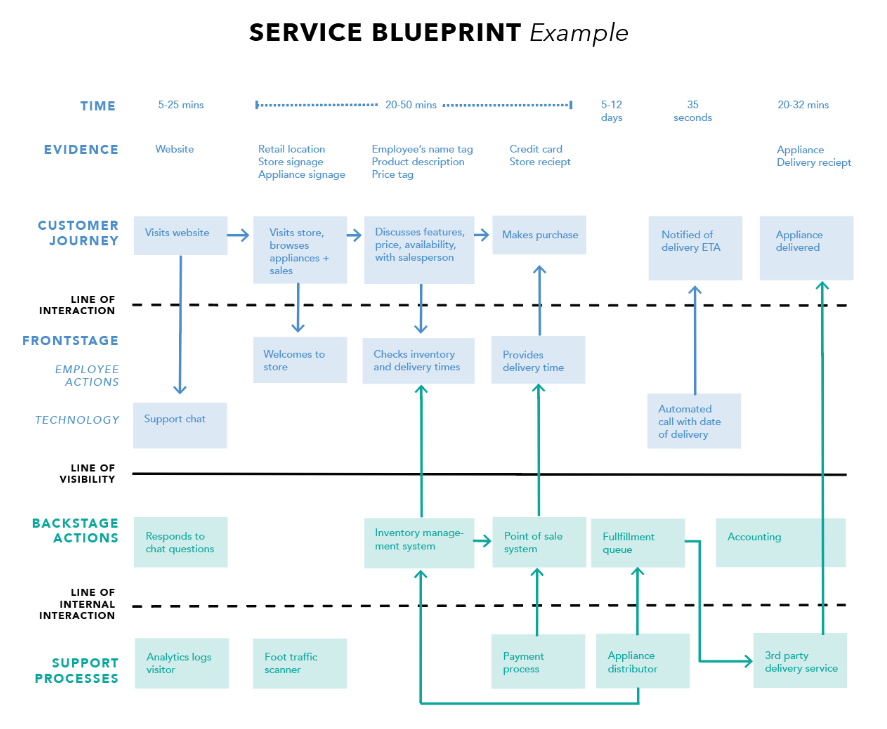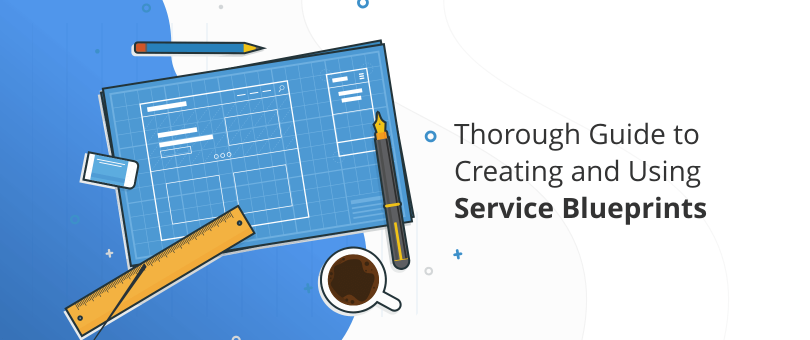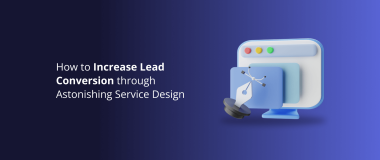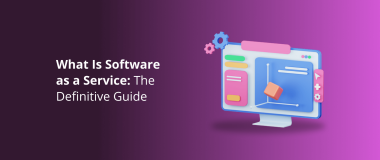No matter what brand story you’re telling, and how well you’re promoting your company, at the end of the day consumers are judging you on the quality of your services. It’s a simple fact. Users approach you due to marketing, they decide to buy from you with the help of inbound marketing and your sales team, and they choose whether to continue being your clients based on your service.
More and more people look for personalization. your potential customers are looking for a personalized service that will fit their needs perfectly. For instance, Spotify enables users to discover more of the music they enjoy, Google – fits your search needs, and Facebook – presents info all topics, brands, communities, and people you’re interested in on your newsfeed.
Using well-known marketing approaches to tailor services to the needs of consumers and market requirements can make you stand out from competitors and convert leads.
How Will a Service Blueprint Help You?

Service Design Example via NNGroup.com
A service blueprint is like a block diagram that presents your users’ journey, interactions between them and your service, channels on which this happens, potential problems, and ideas for resolving them. All these elements are interlinked and give a clear picture of both the user journey and internal processes responsible for it.
This way managers and employees can see and understand the activities and responsibilities of everyone in the company. This approach helps align the efforts within the organization and aim them in a consumer-centric direction.
The service design blueprint also:
- Marks critical moments and helps you come up with effective solutions.
- Gives essential insights when you’re dealing with arduous problems.
- Is Perfect for displaying complex matrixes – cross-channel experiences, various interactions, targeting and retargeting opportunities.
The Essential Elements of a Service Blueprint
To start with the more practical advice, we need to first focus on presenting the building blocks of every service blueprint.
- Ecosystem – The collective whole of all channels, services, interactions, and potential business problems
- Scenario – A particular case that involves your customer experience (front stage) combined with your organization’s internal processes and systems (backstage) of the user journey
- Touchpoint – A single point of interaction between your customer and the service, e.g. requesting a quote, purchasing process, shipment, and delivery, or product’s quality and functionality.
- Channel – A specific medium where interactions take place, e.g. website, Facebook, Twitter, in-app, on the street, in-house.
Start-to-finish Approach
Every blueprint traces the whole user journey from end to end. It begins with a starting point (e.g. entering website) and follows every single step to the last point (making a purchase, subscribing to a newsletter, or receiving the service/product).
A well-done service blueprint should have every step of the user journey separated and linked to the next one to make it easily understandable.
Surface-to-core View
The blueprint’s function is to present an overall picture and look at UX from a holistic 360-degree view. The surface-to core approach focuses on both the user journey and the employee experienced related to developing and maintaining the required service.
It splits the start-to-finish surface into multiple layers that give information on the users, touchpoints, systems, and policies that are all responsible for the final quality. a service blueprint from a consumer journey map and makes it a powerful service design tool.
Drive into the Opportunity Space

Known as the opportunity space in service design, it represents a high-level, not-tightly-specified concept that is part of your service such as “a user registration process” or “purchasing process”.
To be able to dive deeper and review your service 360-degree, you have to brainstorm for potential scenarios that could happen in a particular opportunity space. Such may be “a user trying to purchase without a registered account” or “a user purchases the service successfully”. Discover and mark as many as you can.
The scenarios that are of great interest to you are the ones that are either commonly occurring or arduous (painful for the consumer). You can uncover your consumers’ pain points through researching their psychographics and making buyer personas based on them. Using the data you have about your customers will help you find which high-impact scenarios to focus on.
Play with Your Scenarios
![]()
At this stage, you have to break down your scenarios into steps.
Example: “A user doesn’t provide a real/their email.”
- Step 1: The User Opens the Registration Form
- Step 2: The User Fills Information but Doesn’t Provide Real Email Address
- Step 3: The User Hits the Complete Button
- Step 4: An Email is Sent to the Provided Email Address
- Step 5: The Website Requests Email Authentication to Complete
- Step 6: The User Clicks on “Change Provided Email” Button, Displayed on the Authentication Page in the Website
- Step 7: The User Changes Email Address and Provides Right One
- Step 8: New Email is Sent to the New Provided Email Address
- Step 9: The User Authenticates Email
- Step 10: The User is Allowed Access to Account-only Functionalities In the Website
It’s important to involve a core team of stakeholders, subject matter experts, and people with rich experience in the development of the service blueprint. This will help you:
- Add a Surface-to-Core Depth to present both high-level and detailed view of multiple layers.
- Walk the user journey and identify critical moments and ideas for service improvement such as “Put information under the field where the user provides email, explaining the authentication process”.
- Co-create with each subject matter expert bringing their unique knowledge to polish the service to the very last detail.
Group Critical Moments and Ideas into Broader Themes
![]()
After you’ve identified key touchpoints, potential problems, critical moments, improvement ideas, and ways to resolve probable issues, you have to collect them all into a single place. This allows a more comprehensive approach, not solving problems piece by piece but thoroughly, resulting in service improvement.
At this stage, you have to look for patterns within the collected data and identify larger themes which formulate specific problems. This will help you better understand your weak links and have a clear picture of where to start when resolving issues.
After you’ve marked the broader themes, you have to brainstorm and link them to experiences you want to create for your audience. Start aligning these experiences with your vision to form strategic goals related to improving your services.
These thematic elements and their long-term evolution are what creates the lasting change in what you offer. They serve as the multi-layered approach to resolving numerous small issues with the achievement of a single goal.
Implement Strategy and Tactics
![]()
The experiences you want to produce and the thematic elements help form your strategic goals. They are broad implications that need to be connected on all levels across the company and outline a specific problem you’ve discovered.
However, clearly defined initiatives need to be linked to every strategic goal based on the insights you have from your buyer personas and service blueprint. This approach will help you point out specific actions that each employee needs to perform. It also presents them clearly and aligns efforts across the organization.
While building your service blueprint, you’ll also come across problems that do not need long-term approaches, but rather immediate solutions. These are issues you need to address with tactical fixes which teams can implement immediately.
While using the data from your service blueprint to improve your strategy and tactics .it’s vital to think about the effect a solution will have on all levels of the organization. This approach will help you come up with actionable or possible fixes, rather than unrealistic ones.
Your Services Need a Constant Update
We all live in an era where personalized content and services are all around us. We pay with our phones, discover information based on our interests, and buy products that fit our needs.
To flourish, attract and retain customers, you need to direct your efforts towards the needs of your clients and audience.
To design your service to fit its users, you should follow a strict process that will implement both a start-to-finish approach and a surface-to-core view that enable you to come up with 360-degree solutions that will capture the market!



